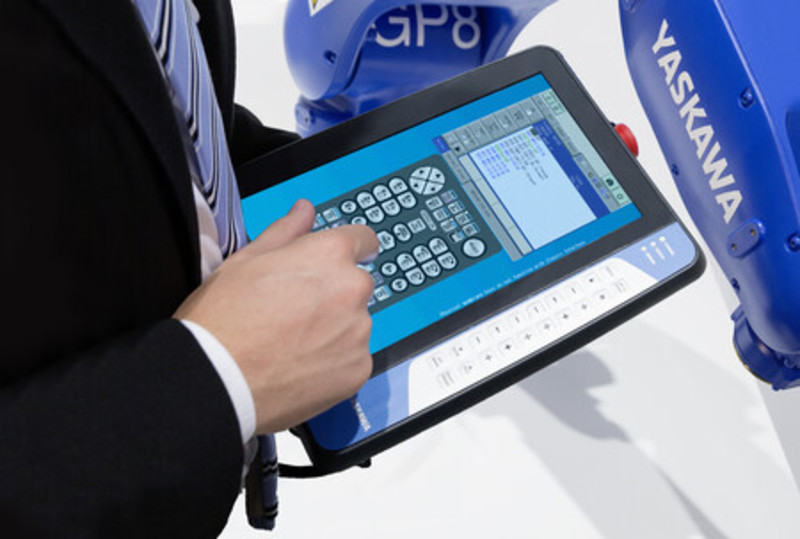Collaborative robots (cobots) aren’t superheroes, but they are rescuing manufacturers of all sizes from the grip of a crippling labor shortage. Companies that once never considered robotic automation are now adopting cobots in their operations because today’s cobots are simple to operate and can handle a wide variety of previously impossible tasks.
Much has changed since IMTS 2018, where a handful of robot manufacturers each had one cobot in their booth. IMTS 2022 promises to be the year of the cobot, with many models and brands on display and in action throughout the show.
“Four years ago, cobots were still fairly new and were not well understood, but today they're absolutely mainstream,” says Joe Campbell, senior manager of strategic marketing and application development at Universal Robots USA (IMTS booth: 236861). “They're the fastest growing segment in factory automation by far.”
Technological advances in ease of use and application flexibility have contributed to the growing popularity of cobots.
Ease of use
A cobot may seem intimidating to program and operate, but in fact, many cobots today are designed with simplified operating and programming features that enable anyone in the shop to learn how to operate them. Cobots are easy to program, with many using a touchscreen teach pendant that leverages icon-based drag and drop functions similar to those of smartphones or tablets.
“Each new generation of operators wants to interact with automation through more of a touchscreen-style interface, so we designed our cobots with this type of user in mind,” says Eric Potter, general manager of the general industries and automotive segment at FANUC America (IMTS booths: 338919 and 215500.
Instead of requiring knowledge of programming languages, some cobots can be hand-guided through a programming path. While in teach mode, operators can grab the robot itself and manually position it through each stage of the process instead of programming it from an interface.
To further simplify programming, Yaskawa America (IMTS booth: 236601) has introduced its Smart Pendant.
“One of the most frightening things for a new programmer to get over quite often is remembering what the X-, Y-, and Z-directions are for each machine,” says Dean Elkins, material handling segment leader at Yaskawa. “The Smart Pendant uses an IMU (inertial measurement unit) to orient the operator to the machine, so they can move the cobot relative to the direction in which they are standing. This sort of simplicity has fueled the acceptance of cobots in a big way.”
Flexibility
Once considered to be just a machine tending solution, cobots have evolved to take on jobs throughout the shop, such as assembly, inspection, welding, and palletizing. Cobots with higher payloads can handle heavier items, while some newer cobot models are mounted on mobile carts so users can quickly move them to different machines as needed.
A growing application is part inspection — a repetitive, sometimes boring task that still requires high precision. Smart vision accessories can easily integrate with cobots to assist in quality control and inspection operations.
“Given the ongoing challenge of meeting staffing needs in manufacturing, further exacerbated by the pandemic, cobots are perfect for the menial tasks so employees can be better used in higher value-add operations such as preparing or finishing parts or programming machines,” Potter adds.
For palletizing operations, a cobot can be put at the end of a conveyor to load packaged parts on pallets for shipping. Cobots are also well suited for welding processes that require a high level of technical skill, complicated movements, or great dexterity, because they precisely lay a consistent weld bead and can move anywhere around the weldment.
Manufacturers considering a cobot can see the latest technology and speak one-on-one with cobot experts at IMTS 2022 to get the information they need to make an educated decision.
Cobots at IMTS 2022
New, easily programmable cobots specializing in inspection, palletizing, welding, and machine tending will be showcased at IMTS 2022. Visit the IMTS 2022 exhibitor page for a full list of collaborative robot exhibitors. Here are just a few:
FANUC America will introduce new additions to its family of cobots, the CRX series, at IMTS 2022. These cobots are designed for small- to mid-sized manufacturers considering automation for the first time, featuring advantages in ease of programming, set up, and overall flexibility. Plus, FANUC offers eight years of maintenance-free operation.
Yaskawa America will have multiple cobots in action, including the demonstration of machine tool loading, unloading, and palletizing with its HC series cobots. Attendees are invited to get a hands-on lesson in programming at the booth.
Universal Robots USA will demonstrate cobots performing machine tending, machine loading and unloading, arc welding, plasma cutting, and surface finishing. These cobots will feature seamlessly integrated components, grippers, software, and safety accessories from the UR+ line of certified kits and components.
See It All at IMTS 2022
Explore more companies exhibiting cobots and dozens more exhibiting robots and robotic accessories to empower your manufacturing facility at IMTS 2022.
Register now and book your hotel room for IMTS 2022.





